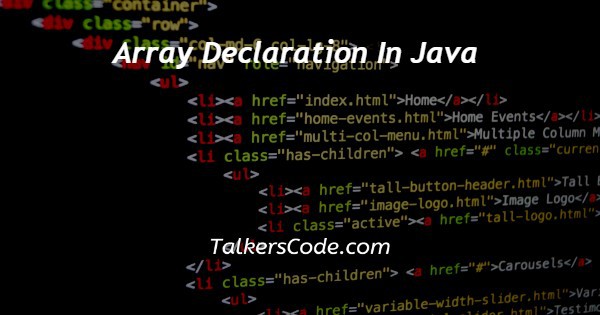In this article we will show you the solution of array declaration in java, by definition, the array is a group of data that has been typed in the same way.
An array is often stated in order to have different value in the same memory, as opposed to variable, which can only get one value with in memory.
As a result, arrays enable you to declare a variable that stores numerous values collectively as opposed to establishing a variable for every value.
The term element refers to the data itself, whereas index refers to a particular data point's position inside the array.
Step By Step Guide On Array Declaration In Java :-
An array is a group of elements with similar types that are stored together in a consist of a single memory space.
Combining related data types results in the creation of an object known as a Java array.
In addition, the components of an array are kept in a single continuous memory space.
This data structure is used to store comparable components.
A Java array can only hold a certain amount of elements. Index 0 represents the first element of an array, index 1 represents the second element, and so forth. Java arrays are built on indexes.
import java.io.*;
import java.util.Arrays;
public class Main {
public static void main(String[] args)
{
int[] arr;
arr = new int[5];
arr[0] = 10;
arr[1] = 20;
arr[2] = 30;
arr[3] = 40;
arr[4] = 50;
for (int i = 0; i < arr.length; i++)
System.out.println("Element at index " + i
+ " : " + arr[i]);
}
}
- You can see that we created a Java application to demonstrate constructing an array of integer, added some values to the array, and printed every value to standard output.
- The import java.io* package is imported on the initial line of code. This indicates that all of the io package's classes can be imported.
- Operation input and output are handled by the java.io package. Several classes in Java IO manage input and output sources.
- The package is imported in the following line of code java.util.Arrays
- There are numerous static methods in arrays. Static methods are a part of a class and can be called without a class object.
- Then, we create a public class called main that begins with the main method after creating a public static void main.
- After that, we declare an integer array and set aside space in memory for five integers.
- The first element of an array is initialised next, followed by the second and so on.
- Then we access the array's specified elements. The array's index is used to access each element.
- Java for Loop can be used to retrieve every element of an array.
Conclusion :-
We were able to fully understand the Java concept of array declaration as a result.
Also, we discovered that even though the first declaration of int Array declares it as an array variable, there isn't any actual array there.
It basically tells the compiler that this variable's integer array (int Array) will contain an array.
One applying new must be assigned and charged to int Array in order to connect it to a real, physical array of numbers.
I hope this article on array declaration in java helps you and the steps and method mentioned above are easy to follow and implement.














